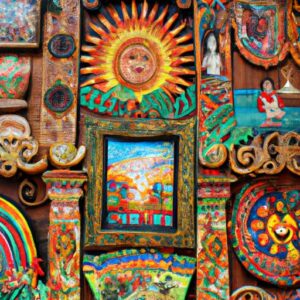Introduction
Contemporary art: a term often thrown around, but what does it really mean? In simple terms, contemporary art refers to artworks created by artists living and working in the present era. It is a dynamic and ever-evolving form of artistic expression that reflects the current cultural, social, and political landscapes. But, the question arises: is contemporary art truly relevant to this modern day generation?
To answer this question, we must first delve into the interests and preferences of the modern day generation. In an era dominated by technology and rapid change, the modern day generation seeks experiences that resonate with their fast-paced lives. They crave authenticity, relatability, and a connection to the world around them. With this in mind, let’s explore how contemporary art aligns with these desires and why it holds significance for the present generation.
The modern day generation is characterized by its diversity, open-mindedness, and desire for individuality. Contemporary art perfectly encapsulates these qualities. It breaks away from traditional artistic norms, embracing a wide range of mediums, styles, and concepts. From abstract paintings to interactive installations, contemporary art offers a plethora of avenues for self-expression and exploration. It allows artists to push boundaries, challenge societal norms, and provide fresh perspectives on the world we live in.
Moreover, contemporary art is a direct response to the issues and concerns that define our time. It serves as a mirror, reflecting the cultural, social, and political complexities that shape the modern day generation’s experiences. Through their work, contemporary artists tackle topics such as climate change, gender equality, identity, and globalization. They provoke thought, spark conversations, and offer new insights into these pressing matters.
In conclusion, contemporary art is not only relevant but vital to the modern day generation. It serves as a catalyst for cultural dialogue, personal growth, and social change. By embracing the diversity and dynamism of contemporary art, we can deepen our understanding of the world we live in and foster a more inclusive and empathetic society. So, let’s embark on this artistic journey together and discover the transformative power of contemporary art.
Understanding Contemporary Art
A. Characteristics and Features of Contemporary Art
Contemporary art is a vibrant and diverse form of artistic expression that embodies the spirit of our modern era. It is characterized by its ability to push boundaries, challenge conventions, and evoke emotions. Unlike traditional art forms, contemporary art embraces a wide range of mediums, including painting, sculpture, photography, performance art, and digital media. This versatility allows artists to experiment and explore new ways of conveying their ideas.
One of the key features of contemporary art is its emphasis on individuality and subjective interpretation. Artists often aim to evoke personal responses from viewers, encouraging them to engage with the artwork on an emotional and intellectual level. The meaning behind contemporary art is not always immediately apparent, and it often invites viewers to question and explore their own perceptions and biases.
Another notable characteristic of contemporary art is its responsiveness to societal changes. As our world rapidly evolves, so does the art that reflects it. Contemporary artists are keen observers of the world around them, addressing current cultural, social, and political issues through their work. They act as cultural commentators, raising awareness, challenging norms, and provoking thought through their artistic endeavors.
B. Evolution of Contemporary Art in Relation to Societal Changes
Contemporary art has evolved in tandem with the societal changes that have shaped our modern world. Over the years, artists have responded to shifting cultural landscapes, technological advancements, and global events, resulting in a diverse array of artistic movements and styles.
In the late 19th and early 20th centuries, the birth of modernism marked a significant turning point in the art world. Artists such as Pablo Picasso and Wassily Kandinsky rejected traditional artistic conventions and embraced abstraction, paving the way for the experimentation and innovation that define contemporary art.
As society became more interconnected and globalized, contemporary art began to reflect the complexities of our interconnected world. Artists started exploring themes of identity, globalization, and cultural diversity, challenging established narratives and offering new perspectives.
In recent years, the rise of digital media and technology has further influenced the evolution of contemporary art. Artists now incorporate interactive installations, virtual reality experiences, and digital platforms to engage with audiences in innovative ways. This integration of technology has opened up new possibilities for artistic expression and expanded the reach and accessibility of contemporary art.
In summary, understanding contemporary art requires recognizing its distinct characteristics and understanding its evolution in response to societal changes. By embracing its diversity, subjectivity, and responsiveness, we can truly appreciate the relevance and impact of contemporary art on our modern day generation.
Relevance of Contemporary Art to the Modern Day Generation
Reflection of Current Cultural, Social, and Political Issues
Contemporary art serves as a powerful medium for reflecting the current cultural, social, and political issues that shape our world. Artists have always been at the forefront of societal movements, using their creative expressions to challenge the status quo and advocate for change. In today’s fast-paced and interconnected world, contemporary art acts as a powerful mirror, reflecting the realities and concerns of the modern day generation.
Through their artwork, contemporary artists capture the essence of our cultural zeitgeist. They explore themes such as identity, diversity, and inclusivity, offering nuanced perspectives on the complex tapestry of our society. Whether it’s through paintings, sculptures, or multimedia installations, contemporary art engages with the cultural discourse, fostering dialogue and provoking thought among the modern day generation.
Addressing the Concerns and Experiences of the Modern Day Generation
One of the reasons contemporary art holds relevance for the modern day generation is its ability to address their unique concerns and experiences. The challenges faced by this generation, such as environmental crises, social inequality, and mental health issues, find resonance in the works of contemporary artists.
Contemporary art provides a platform for artists to express their own experiences and emotions, giving voice to the struggles and triumphs of the modern day generation. It offers a space for exploration and reflection, allowing individuals to connect with the artists’ narratives and find solace in shared experiences. By addressing these concerns, contemporary art provides validation, empathy, and catharsis to those navigating the complexities of the modern world.
Moreover, contemporary art encourages active engagement and participation from its viewers. It invites dialogue, encourages critical thinking, and challenges preconceived notions. By actively involving the audience in the interpretation and creation of meaning, contemporary art empowers the modern day generation to question, reflect, and take action.
In summary, contemporary art’s relevance to the modern day generation lies in its ability to reflect and respond to current cultural, social, and political issues. By addressing the concerns and experiences of this generation, contemporary art offers a platform for dialogue, self-reflection, and social change. It resonates with the modern day generation’s quest for authenticity, connection, and understanding of the world around them.
Engagement and Interaction with Contemporary Art
Influence of Technology and Digital Platforms on Contemporary Art
In this digital age, technology has revolutionized the way we engage with contemporary art. It has opened up a whole new realm of possibilities for artists to create and for audiences to experience art. With the advent of digital platforms and social media, contemporary art has become more accessible than ever before.
Technology has enabled artists to experiment with new mediums and techniques, blurring the boundaries between traditional and digital art forms. From digital paintings to immersive virtual reality experiences, technology has expanded the artistic landscape and provided artists with innovative tools for self-expression. Through the use of digital platforms, artists now have the ability to reach a global audience with just a click of a button.
Furthermore, digital platforms have democratized the art world, making contemporary art more inclusive and diverse. Online galleries and art marketplaces have created spaces where emerging artists can showcase their work alongside established names. This has given rise to a vibrant and interconnected community of artists and art enthusiasts, fostering collaboration, dialogue, and support.
Accessibility and Inclusivity of Contemporary Art for the Modern Day Generation
Contemporary art has evolved to become more accessible and inclusive, catering to the modern day generation’s diverse interests and preferences. Museums and galleries have embraced interactive exhibits, multimedia installations, and engaging educational programs to attract and engage a broader audience.
Additionally, contemporary art has moved beyond the confines of traditional art spaces. Public art installations, street art, and community projects have become prevalent, bringing art directly into the everyday lives of people. This shift allows for a more immersive and relatable experience, encouraging active participation and interaction with art.
Moreover, contemporary art has embraced inclusivity by addressing a wide range of themes and narratives that resonate with the modern day generation. Artists are exploring issues of race, gender, identity, and social justice, giving voice to marginalized communities and challenging existing power structures. By doing so, contemporary art becomes a powerful tool for social change and advocacy.
In conclusion, the influence of technology and the increased accessibility of contemporary art have transformed the way we engage and interact with art. Digital platforms have expanded artistic possibilities, connecting artists and audiences worldwide. Meanwhile, the inclusive nature of contemporary art ensures that diverse voices are heard and represented. Through these advancements, the modern day generation can actively participate in the artistic process, fostering a deeper appreciation and understanding of contemporary art.
Impact and Influence of Contemporary Art
Contemporary art goes beyond its aesthetic appeal; it holds the power to shape cultural identities and perspectives, leaving a lasting impact on the modern day generation. Let’s explore how contemporary art influences our society and inspires creativity, critical thinking, and self-expression.
Shaping Cultural Identities and Perspectives
Contemporary art serves as a reflection of the diverse cultures and identities that exist in our world today. It amplifies marginalized voices, challenges stereotypes, and celebrates the richness of our multicultural society. Through their artwork, contemporary artists explore themes of race, gender, sexuality, and ethnicity, offering a platform for underrepresented experiences to be seen and heard.
By portraying a range of perspectives, contemporary art encourages empathy and understanding, fostering a sense of unity amongst the modern day generation. It allows us to question preconceived notions, challenge biases, and appreciate the beauty of our differences. Through the exploration of cultural identities in contemporary art, we can create a more inclusive and harmonious society.
Inspiring Creativity, Critical Thinking, and Self-Expression
Contemporary art goes beyond mere visual pleasure; it ignites the spark of creativity, stimulates critical thinking, and encourages self-expression among the modern day generation. By pushing the boundaries of traditional art forms, contemporary artists inspire us to think outside the box and explore uncharted territories.
Through their innovative approaches, contemporary artists challenge us to question the status quo and examine our own beliefs and values. They invite us to engage in a dialogue with the artwork, stimulating our intellectual curiosity and expanding our perspectives. Contemporary art encourages us to ask why and how, fostering a culture of inquiry and intellectual growth.
Furthermore, contemporary art empowers individuals to express themselves authentically. It provides a medium for personal narratives, emotions, and experiences to be shared. By engaging with contemporary art, the modern day generation can find a voice, explore their own identities, and communicate their unique perspectives to the world.
In conclusion, contemporary art’s impact on the modern day generation is profound. It shapes cultural identities, challenges societal norms, and promotes inclusivity. Moreover, it inspires creativity, critical thinking, and self-expression, empowering individuals to embrace their unique voices. By embracing the influence of contemporary art, we can foster a more creative, introspective, and empathetic world.
Conclusion
Contemporary art: a vibrant tapestry woven with creativity, diversity, and relevance. Throughout this article, we have explored the intricacies of contemporary art and its profound connection to the modern day generation. From its ability to reflect the current cultural, social, and political climate to its capacity to inspire critical thinking and self-expression, contemporary art stands as a testament to the power of artistic expression.
In a world marked by constant change and technological advancements, contemporary art serves as a beacon of authenticity and connection. It invites us to engage with the issues that define our time, offering fresh perspectives and challenging our preconceived notions. Through its ever-evolving nature, contemporary art captures the essence of our present era, making it a valuable source of cultural dialogue and societal transformation.
But the relevance of contemporary art extends beyond its ability to mirror our world. It also holds the potential to shape cultural identities, ignite creativity, and foster a sense of belonging for the modern day generation. By engaging with contemporary art, we can tap into our own individuality, explore diverse narratives, and find common ground in our shared human experiences.
So, as we stand at the crossroads of art and this modern day generation, let us embrace the beauty and significance of contemporary art. Let us be curious, open-minded, and willing to immerse ourselves in the transformative power of artistic expression. Whether we are artists, enthusiasts, or casual observers, let us recognize that contemporary art is not just relevant, but essential for our collective growth and understanding.
In the end, it is you, the modern day generation, who holds the key to unlocking the profound impact of contemporary art. So, go forth and explore, question, and engage with the artistic wonders that surround you. Let contemporary art be your guide, your inspiration, and your catalyst for change. Together, we can create a world where art is not only relevant but celebrated as an integral part of our modern day lives.





